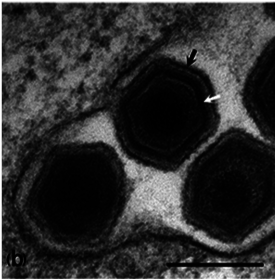Keeping up with virus taxonomy: biopesticides, African swine fever and plant diseases
Posted on November 30, 2018 by Laura Cox
Continuing the ‘Keeping up with virus taxonomy’ blog series, in this post we will be discussing the virus that causes African Swine Fever, a family of viruses that infects insect larvae, and the Geminiviridae — members of which cause some of the most economically-important plant diseases in the world.
ICTV Taxonomy profiles are published in the Journal of General Virology and provide concise overviews of the classification, structure and properties of virus orders, families and genera. In this series, Microbe Post will be investigating the families published as ICTV Taxonomy Profiles, as well as continuing the discussion on the changing field of taxonomy.

African swine fever virus
The Asfarviridae family includes a single species: African swine fever virus. African swine fever virus (ASFV) infects the white blood cells of domestic and wild pigs. ASFV — which is thought to be spread by ticks — causes a chronic, subacute disease in African warthogs and bushpigs. However, in domestic pigs and wild boar, the virus causes a severe haemorrhagic fever that can be deadly. ASFV is endemic to sub-Saharan Africa, but its range is increasing, with a periodic spread to Europe. There are recent reports of the virus in wild boar in Belgium and Asia.
African swine fever virus shares around 30 genes with the unclassified viruses faustovirus Pacmanvirus and kaumoebavirus. These are giant viruses (their genomes are more than twice as large as asfarviruses) that infect amoebae.
This family consists of over 60 species across four genera. Baculoviruses are large, and depending on their genus, infect the larvae of butterflies and moths, sawflies or mosquitoes. Some members of this virus family have been used as biopesticides to control insect pests.
There are nine genera in the Geminiviridae family, which includes over 440 species. Members of this family of viruses infect plants; including grapevines, spinach, beans, peas, peanuts and lentils. Viruses in this family are spread by insects. The insect vectors vary depending on the virus’ genus; for example, viruses in the Begomovirus genus are transmitted between plants by whiteflies. Infection with geminiviruses can cause reduced plant yield, leaf curling, stunted growth and mottling making this virus family responsible for significant amount of crop damage worldwide.
Viruses in this family tend to be named after the plant disease they cause. Some examples are:

A tomato plant infected with
tomato yellow leaf curl
- beet curly top Iran virus
- tomato yellow leaf curl virus
- grapevine red blotch virus
The International Committee on Taxonomy of Viruses (ICTV) is responsible for developing and maintaining a universal virus taxonomy. Known viruses are categorised into a classification scheme taking into consideration their physical and biological properties in combination with their phylogenetic relationships.
Thanks to funding from the Wellcome Trust, two-page summaries of each chapter of the ICTV Report (a free resource published by the ICTV which provides an up-to-date description of virus taxonomy) are freely available in the Journal of General Virology. These summaries are known as ICTV Virus Taxonomy Profiles and describe the structure, replication and taxonomy of each virus order and family.

